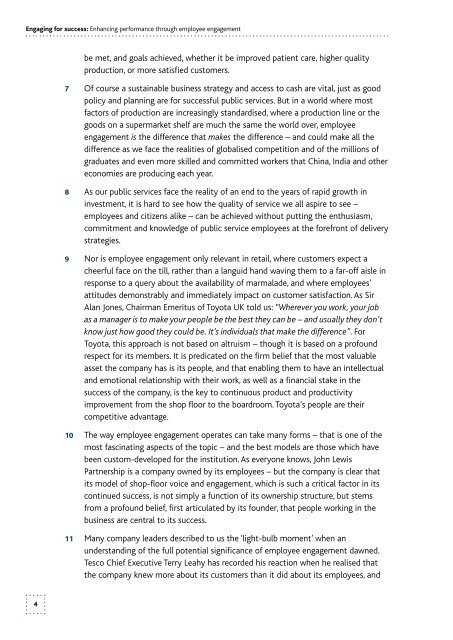3ytgeaf
3ytgeaf
3ytgeaf
You also want an ePaper? Increase the reach of your titles
YUMPU automatically turns print PDFs into web optimized ePapers that Google loves.
Engaging for success: Enhancing performance through employee engagement<br />
be met, and goals achieved, whether it be improved patient care, higher quality<br />
production, or more satisfied customers.<br />
7 Of course a sustainable business strategy and access to cash are vital, just as good<br />
policy and planning are for successful public services. But in a world where most<br />
factors of production are increasingly standardised, where a production line or the<br />
goods on a supermarket shelf are much the same the world over, employee<br />
engagement is the difference that makes the difference – and could make all the<br />
difference as we face the realities of globalised competition and of the millions of<br />
graduates and even more skilled and committed workers that China, India and other<br />
economies are producing each year.<br />
8 As our public services face the reality of an end to the years of rapid growth in<br />
investment, it is hard to see how the quality of service we all aspire to see –<br />
employees and citizens alike – can be achieved without putting the enthusiasm,<br />
commitment and knowledge of public service employees at the forefront of delivery<br />
strategies.<br />
9 Nor is employee engagement only relevant in retail, where customers expect a<br />
cheerful face on the till, rather than a languid hand waving them to a far-off aisle in<br />
response to a query about the availability of marmalade, and where employees’<br />
attitudes demonstrably and immediately impact on customer satisfaction. As Sir<br />
Alan Jones, Chairman Emeritus of Toyota UK told us: “Wherever you work, your job<br />
as a manager is to make your people be the best they can be – and usually they don’t<br />
know just how good they could be. It’s individuals that make the difference”. For<br />
Toyota, this approach is not based on altruism – though it is based on a profound<br />
respect for its members. It is predicated on the firm belief that the most valuable<br />
asset the company has is its people, and that enabling them to have an intellectual<br />
and emotional relationship with their work, as well as a financial stake in the<br />
success of the company, is the key to continuous product and productivity<br />
improvement from the shop floor to the boardroom. Toyota’s people are their<br />
competitive advantage.<br />
10 The way employee engagement operates can take many forms – that is one of the<br />
most fascinating aspects of the topic – and the best models are those which have<br />
been custom-developed for the institution. As everyone knows, John Lewis<br />
Partnership is a company owned by its employees – but the company is clear that<br />
its model of shop-floor voice and engagement, which is such a critical factor in its<br />
continued success, is not simply a function of its ownership structure, but stems<br />
from a profound belief, first articulated by its founder, that people working in the<br />
business are central to its success.<br />
11 Many company leaders described to us the ‘light-bulb moment’ when an<br />
understanding of the full potential significance of employee engagement dawned.<br />
Tesco Chief Executive Terry Leahy has recorded his reaction when he realised that<br />
the company knew more about its customers than it did about its employees, and<br />
4


